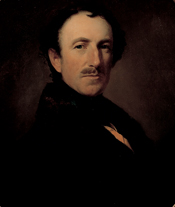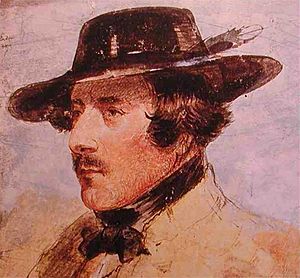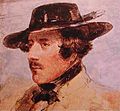William Drummond Stewart facts for kids
Quick facts for kids
Sir William Drummond Stewart, Bt
|
|
|---|---|
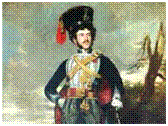
Portrait of Sir William Drummond Stewart in Murthly Castle
|
|
| Born | 26 December 1795 Murthly Castle, Perthshire |
| Died | 28 April 1871 (aged 75) |
| Buried |
Chapel of St. Anthony the Eremite, Murthly Castle
|
| Allegiance | |
| Service/ |
|
| Years of service | 1812–1820 |
| Rank | Captain |
| Unit | 6th Dragoon Guards 15th The King's Hussars |
| Battles/wars | Peninsular War Waterloo |
| Awards | Knight of the Military Order of Christ |
Sir William Drummond Stewart, 7th Baronet (born December 26, 1795 – died April 28, 1871) was a Scottish adventurer and a British Army officer. He spent almost seven years exploring the American West in the 1830s. In 1837, he hired American artist Alfred Jacob Miller to draw sketches of his travels. Many of Miller's paintings of Native American life and the Rocky Mountains once hung in Murthly Castle. Today, these artworks are found in various private and public collections.
After his older brother died in 1838, William inherited the family title and returned to Scotland. He came back to America in 1842. In the summer of 1843, he hosted a special party in the Rocky Mountains at a remote lake, now called Fremont Lake. For this trip, Jean Baptiste Charbonneau, the son of Sacagawea from the Lewis and Clark Expedition, helped care for the mules. The trip ended earlier than planned due to a disagreement within the group.
Contents
Early Life and Military Service
William Stewart was born at Murthly Castle in Perthshire, Scotland. He was the second son in a family of seven children. His family decided he would join the Army because his older brother would inherit their father's estate and title. In 1812, after turning seventeen, William asked his father to buy him a position in the 6th Dragoon Guards. He joined his regiment in 1813 and began his military training.
Joining the Hussars
Stewart was eager to see military action. In December 1813, his father helped him get a promotion to Lieutenant in the 15th The King's Hussars. This regiment was already fighting in the Peninsula Campaign. Stewart joined his new regiment in January 1814. He later fought in the famous Waterloo campaign in 1815. In 1820, Stewart was promoted to Captain and soon after retired from active duty.
Family Life
William Stewart had a son named William George Drummond Stewart, born in 1831. He supported his son and the boy's mother financially. Later, he married the mother to ensure his son could inherit his property. Stewart also traveled extensively with his friend Antoine Clement for many years.
His Son's Career and Death
His son, William George Drummond Stewart, had a distinguished career in the British Army. He received the Victoria Cross for his bravery during the Indian Rebellion of 1857. Sadly, the younger Stewart died before his father. He passed away in 1868 from an accident involving sword swallowing.
Adventures in the American West
Looking for excitement, Stewart traveled to St. Louis, Missouri in 1832. There, he met important people like William Clark and Pierre Chouteau Jr.. He arranged to join a group traveling to the 1833 rendezvous of mountain men. A "rendezvous" was a large meeting where fur traders and Native Americans gathered to trade goods and share stories.
Exploring the Frontier
Stewart's group left St. Louis in May and attended the Horse Creek Rendezvous in Wyoming. Here, Stewart met famous mountain men like Jim Bridger and Thomas Fitzpatrick. He also met Benjamin Bonneville, who was leading a government exploration. Stewart visited the Big Horn Mountains and spent a winter in Taos, New Mexico. He attended another rendezvous at Ham's Fork of the Green River. Later that year, he journeyed to Fort Vancouver, near the Pacific Ocean.
Stewart attended the 1835 rendezvous. He returned to St. Louis in November. He faced some money problems because his brother had not sent his share of their father's estate. Stewart went to New Orleans, invested in cotton to earn money, and spent a winter in Cuba. In May, he joined another group heading to the Rockies for a rendezvous. He spent the winters of 1836-1837 and 1837-1838 in New Orleans, again investing in cotton. In 1838, he learned that his older brother John had died. William Stewart then became the seventh baronet of Murthly.
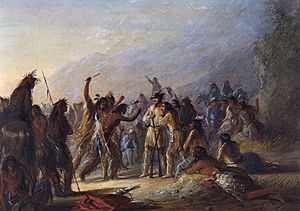
For the Rocky Mountain Rendezvous of 1837, Stewart brought along American artist Alfred Jacob Miller. Miller created many famous paintings of the mountain men, the rendezvous, American Indians, and Rocky Mountain landscapes. In 1839, Miller delivered the finished oil paintings to Stewart, who displayed them at Dalpowie Lodge on his Murthly estate. Miller painted many of these works while staying at the estate, using the watercolor sketches he made during their trip.
Return to Scotland and Later Travels
Stewart returned to Scotland and Murthly Castle in June 1839 with his traveling companion, Antoine Clement. They lived at Dalpowie Lodge and entertained guests at Murthly Castle. Clement found Scotland restless, so they spent many months traveling abroad, including a long visit to the Middle East.
Stewart's older brother had accumulated many debts while building a new Murthly Castle. Attempts to earn money by hosting hunting parties were not successful. Stewart eventually sold one of the family's estates, Logiealmond Castle. This sale provided enough money to pay off his brother's debts and allowed him to return to the United States for a large, fancy party in the Rockies.
Stewart returned to North America in late 1842. In September 1843, he and a large group traveled to what is now Fremont Lake. Stewart brought many velvet and silk costumes for his guests to wear during the celebrations. Fur trader William Sublette helped host the party with Stewart. Although there had been no official rendezvous since 1840, this party had many features of the old Rocky Mountain gatherings. Stewart had planned to spend the winter of 1843–1844 in New Orleans and visit Taos and Santa Fe the next spring. However, the trip ended unexpectedly, causing him to leave for Scotland immediately. He never returned to the United States.
Stewart died from pneumonia on April 28, 1871.
Images for kids


